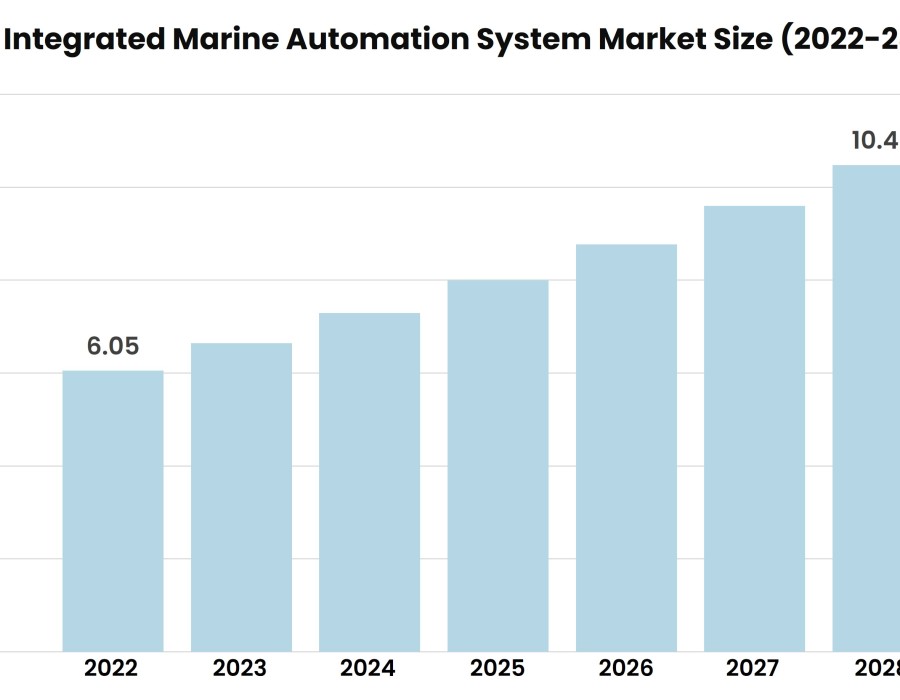The maritime industry is increasingly adopting integrated marine automation systems (IMAS) to streamline operations, enhance safety, and improve efficiency. These systems automate critical processes such as navigation, propulsion control, power management, and cargo handling, helping vessels achieve optimal performance. As this market continues to grow, several key drivers are accelerating its expansion, while challenges remain that could hinder progress. This article delves into both the drivers and challenges shaping the integrated marine automation systems market.
According to Stratview Research, the integrated marine automation system market was estimated at USD 6.05 billion in 2022 and is likely to grow at a CAGR of 9.55% during 2023-2028 to reach USD 10.48 billion in 2028.
Key Industry Drivers
- Operational Efficiency and Cost Reduction: One of the primary drivers of the IMAS market is the growing need for greater operational efficiency. Automation systems centralize control, allowing ship operators to monitor and manage various vessel functions in real-time. This reduces human error, optimizes fuel consumption, and minimizes operational costs, particularly in the context of rising fuel prices. Automated systems also enable more precise navigation and route optimization, which can reduce voyage times and fuel consumption.
- Regulatory Compliance: The global maritime industry is under increasing regulatory pressure to reduce emissions and enhance safety. The International Maritime Organization (IMO) has introduced several key regulations, such as the Energy Efficiency Design Index (EEDI) and the Global Sulfur Cap, which set strict limits on vessel emissions. Integrated marine automation systems help vessels comply with these regulations by optimizing energy use and emissions control systems. Additionally, automation aids in monitoring environmental parameters, such as ballast water management and exhaust emissions, ensuring regulatory compliance.
- Technological Advancements: The integration of emerging technologies, including artificial intelligence (AI), machine learning (ML), and the Internet of Things (IoT), is driving innovation in the IMAS market. AI and ML allow for predictive maintenance, enabling ship operators to detect potential failures before they occur and thus reducing downtime. IoT-connected sensors collect and transmit real-time data, allowing for better decision-making and operational efficiency.
Key Challenges
- High Capital Investment: One of the significant challenges in adopting integrated marine automation systems is the high upfront cost of installation and implementation. The integration of advanced automation technologies into existing vessels requires substantial financial investments, which can be a barrier for smaller shipping companies. The cost of upgrading older fleets can also be prohibitive, slowing down widespread adoption.
- Cybersecurity Risks: As vessels become increasingly connected, cybersecurity has emerged as a critical challenge. Automated systems rely on real-time data transmission and digital infrastructure, making them vulnerable to cyberattacks. The maritime industry has faced growing concerns about potential threats, such as system breaches or hacking, which could lead to operational disruptions or even safety risks. Ensuring robust cybersecurity protocols and solutions is vital to mitigating these risks.
- Lack of Skilled Personnel: The implementation and operation of sophisticated automation systems require highly skilled personnel. There is a growing gap in the availability of crew members and operators who are trained to manage these systems. This shortage of expertise is hindering the smooth adoption of IMAS and increasing operational risks for vessels that rely on automated processes.
Conclusion
The integrated marine automation systems market is driven by the pursuit of operational efficiency, regulatory compliance, and technological innovation. However, challenges such as high capital investment, cybersecurity risks, and a shortage of skilled personnel present obstacles that the industry must overcome. As the market continues to evolve, addressing these challenges will be essential to fully realizing the potential of IMAS in shaping the future of maritime operations.






Comments